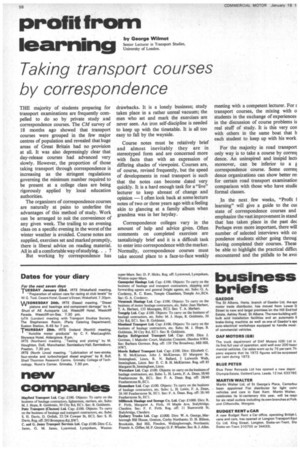profit from learning
Page 60

If you've noticed an error in this article please click here to report it so we can fix it.
by George Wilmot
Senior Lecturer in Transport Studies, University of London.
Taking transport courses by correspondence
THE majority of students preparing for transport examinations are frequently compelled to do so by private study and correspondence courses. The CM survey of 18 months ago showed that transport courses were grouped in the few major centres of population and revealed that huge areas of Great Britain had no provision at all. It was also depressingly clear that day-release courses had advanced very slowly. However, the proportion of those taking transport through correspondence is increasing as the stringent regulations governing the minimum number required to be present at a college class are being rigorously applied by local education authorities.
The organizers of correspondence courses are naturally at pains to underline the advantages of this method of study. Work can be arranged to suit the convenience of any given week. The trailing to an evening class on a specific evening in the worst of the winter weather is avoided. Course notes are supplied, exercises set and marked promptly, there is liberal advice on reading material. All in all a comfortable way of studying. . . ?
But working by correspondence has drawbacks. It is a lonely business; study takes place in a rather unreal vacuum; the men who set and mark the exercises are never seen. An iron self-discipline is needed to keep up with the timetable. It is all too easy to fall by the wayside.
Course notes must be relatively brief and almost inevitably they are in stereotyped form and are concerned more with facts than with an expression of differing shades of viewpoint. Courses are, of course, revised frequently, but the speed of developments in road transport is such that the notes can become dated very quickly. It is a hard enough task for a"live" lecturer to keep abreast of change and opinion — I often look back at some lecture notes of two or three years ago with a feeling akin to glancing at a family album when grandma was in her heyday.
Correspondence colleges vary in the amount of help and advice given. Often comments on completed exercises are tantalizingly brief and it is a difficult task to enter into correspondence with the marker. Normally, correspondence courses must take second place to a face-to-face weekly meeting with a competent lecturer. For r transport courses, the mixing with o students in the exchange of experiences in the discussion of course problems is real stuff of study. It is this very con with others in the same boat that h each student to keep up with his work.
For the majority in road transport only way is to take a course by corresi dence. An uninspired and insipid lecti moreover, can be inferior to a g correspondence course. Some cones] dence organizations can show better ret for certain road transport examination comparison with those who have studie formal classes.
In the next few weeks, "Profit f learning" will give a guide to the cui state of correspondence courses and emphasize the vast improvement in stand that has taken place in the past dec Perhaps even more important, there will number of selected interviews with co pondence students either going throug having completed their courses. These be able to highlight the practical diffict encountered and the pitfalls to be avoi




















































































































